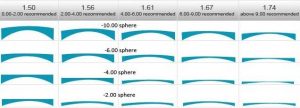What are high-index lenses?
High-index lenses are eyeglass lenses that are designed to be thinner and lighter than regular lenses. They are generally recommended for people who have significantly high refractive errors and strong prescriptions for nearsightedness, farsightedness, or astigmatism.
Regular lenses that contain a strong optical prescription usually require a thicker and heavier lens in order to bend light more effectively and correct the high refractive error.
While both regular and high index lenses function in the same way, high index lenses are designed to bend light more efficiently — leading to thinner and lighter lenses.
Schedule an appointment with an eye doctor to find out if high-index lenses are a good fit.
What is a refractive index?
The refractive index is the number that represents how efficiently a lens material bends light, and is dependent on how quickly light travels through the material.
Regular plastic lenses have a refractive index of 1.50.
This index is adequate for correcting mild to moderate refractive errors, but is not as effective for the correction of higher refractive errors.
A high-index lens may be recommended if your optical prescription is above 2.00 diopters.
High-index lenses have a refractive index above 1.50— ranging from 1.53 to 1.74.
The image below compares the lens thickness of a regular plastic lens (1.50) to the most commonly prescribed high-index lenses.

Note: The higher the refractive index, the thinner the lens.
According to this table, a lens with an index of 1.74 could be up to 50 percent thinner than a regular plastic lens with an index of 1.50, with the same optical prescription.
Polycarbonate lenses have a refractive index of 1.59.
Polycarbonate lenses are impact resistant and offer increased durability, but are generally only recommended for children’s glasses, sports eyewear and safety goggles because they don’t provide the same level of visual clarity, when compared to other plastic lenses.
If you need high-index lenses contact an eye doctor near you to start improving your vision.
SEE RELATED: Glass or Plastic: Which Type of Lens Should You Choose?
Why choose a high-index lens?
If you have a strong prescription and are looking for thinner, lighter lenses with a more attractive appearance, high-index lenses are the way to go.
Thinner lenses
In general, the stronger the prescription, the thicker the lens will be.
A lens for nearsightedness is designed to be thinner in the center but thicker around the edges. With a strong prescription and regular thick lenses, your choice of eyeglass frames will be limited— especially if you were hoping to purchase rimless or semi-rimless frames.
More recently, the newest trends in eyeglass frames include plastic and metal rimless frames, as well as frames that contain thinner rims which expose the edge of the lens.
With a thicker lens, these types of frames can be less attractive and also more difficult to wear, as thicker lenses are not as secure within the frame and are more likely to pop out.
With thinner high-index lenses, you will no longer need to worry about the appearance of your lenses and you will gain a larger variety of frames to choose from.
Lighter lenses
High-index lenses contain less material than regular lenses and are therefore lighter and more comfortable.
Regular lenses for a strong farsightedness prescription can be quite heavy. High-index lenses however, don’t require as much lens material and will result in longer lasting comfort.
Also, as opposed to lenses for nearsightedness which are thicker on the edges, lenses for farsightedness are thicker in the center. With regular lenses, this can significantly magnify your eyes and may make you feel a bit self conscious at times.
High-index lenses contain a unique aspheric design which facilitates a flatter lens curvature, leading to reduced magnification and improved appearance.
Other advantages
High-index lenses are generally scratch resistant and can fit into almost any type of frame. They can also be treated with anti-scratch, anti-reflective, and UV-protection coatings to improve vision and lens durability.
Disadvantages of high-index lenses
Before choosing high-index, speak with your eye doctor to determine if these lenses are necessary for your individual prescription.
While high-index lenses can be beneficial for certain optical prescriptions, they can also be more expensive than regular lenses.
Many eye care professionals also recommend adding anti-reflective and anti-scratch coatings to high-index lenses to improve vision and lens durability — this will further increase the overall cost of your new eyeglasses.
Also, it is important to know that high-index lenses are typically more fragile than regular lenses and need to be handled with a bit more care.
Before purchasing new lenses, discuss the advantages and disadvantages of high-index lenses with your eye doctor.
High-index lenses can improve lens comfort and appearance, and can even open the door to a larger variety of frames. High-index lenses may be just the solution you have been searching for.
LEARN MORE: Optical and Contact Lenses
Contact an eye doctor near you to find out which lenses are best for you and your eyes.









